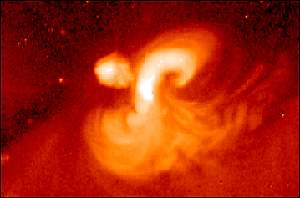
Front Page | |
World | |
UK | |
UK Politics | |
Business | |
Sci/Tech | |
Health | |
Education | |
Sport | |
Entertainment | |
Talking Point | |
In Depth | |
On Air | |
Archive | |
| Feedback Low Graphics Help |
|
Tuesday, March 9, 1999 Published at 17:56 GMT
Sci/Tech
Scientists to forecast sun eruptions

S-shaped swirls on the Sun's surface spell danger
Colossal solar storms which can destroy communication satellites and knock out power grids on Earth may be predictable.
 | |
| SOHO satellite's view of a solar eruption |
Richard Canfield, at Montana State University, USA, led the Nasa-funded research.
"We've found that the S-shaped regions are the dangerous ones. As soon as we can recognize that, we know that it is more likely to erupt," he said.
The researchers have likened each S-shaped feature to a loaded gun with a high probability of going off.
Professor Canfield said ultimately scientists may be able to issue solar eruption warnings just like meteorologists make long range weather forecasts on Earth.
![[ image: After eruption; A more diffuse swirl]](_293638_sun_swirl150.jpg) |
| After eruption; A more diffuse swirl |
They occur several times every day but only those aimed at the Earth are potentially dangerous. It takes only four days for the gases to travel the 93 million miles to our planet.
When they hit the Earth's magnetic field they can cause power cuts and satellite failures. These disrupt the global communications which are so relied upon on today's technology-driven world.
In Canada in March 1989, a solar eruption produced a power surge which caused the entire Quebec hydro-electric system to collapse, cutting off six million people.
'S' spells danger
The S-shaped structures are thought to result from twisted solar magnetic fields. Other magnetically-disturbed regions of the Sun's surface have a symmetrical, butterfly shape and rarely erupt.
Physicists Hugh Hudson and Alphonse Sterling, working at the Institute of Space and Astronautical Science in Japan, first noticed a connection between solar eruptions and S-shapes.
Professor Canfield, with his colleagues in Japan, then looked for a statistically-significant correlation between the two.
The team watched television movies of the Sun. They made these using pictures taken 50 times a day for two years by a Japanese-US-UK satellite called Yohkoh.
The study showed not only that "S" marks the spot of a likely eruption, but also revealed a link between large sun spot areas and solar eruptions. The scientists are now trying to see if the correlations can be turned into a reliable method of prediction.
Professor Canfield said: "We need to get past simple classifications such as`is it S-shaped or not' and get to quantitative measurements that answer `how twisted are the magnetic fields?'
"We also want to know in which direction the CME is going to go. and how many regions are likely to erupt."
Nasa is already planning a mission to help answer these questions. The Solar Terrestrial Relations Observatory will make three-dimensional images of solar eruptions.
The Yohkoh Soft X-Ray Telescope was prepared by the Lockheed Palo AltoResearch Laboratory, the National Astronomical Observatory of Japan,and the University of Tokyo, with the support of NASA and ISAS.
Back to top | BBC News Home | BBC Homepage | © | |
Relevant Stories 04 Feb 99 | Sci/Tech Where the solar wind blows 07 Sep 98 | Sci/Tech Grabbing a piece of the sun 28 Apr 98 | Sci/Tech Solar pictures amaze scientists |
| Internet Links |
Corronal mass ejection prediction Yohkoh satellite SOHO: Corronal mass ejection |
The BBC is not responsible for the content of external internet sites. |